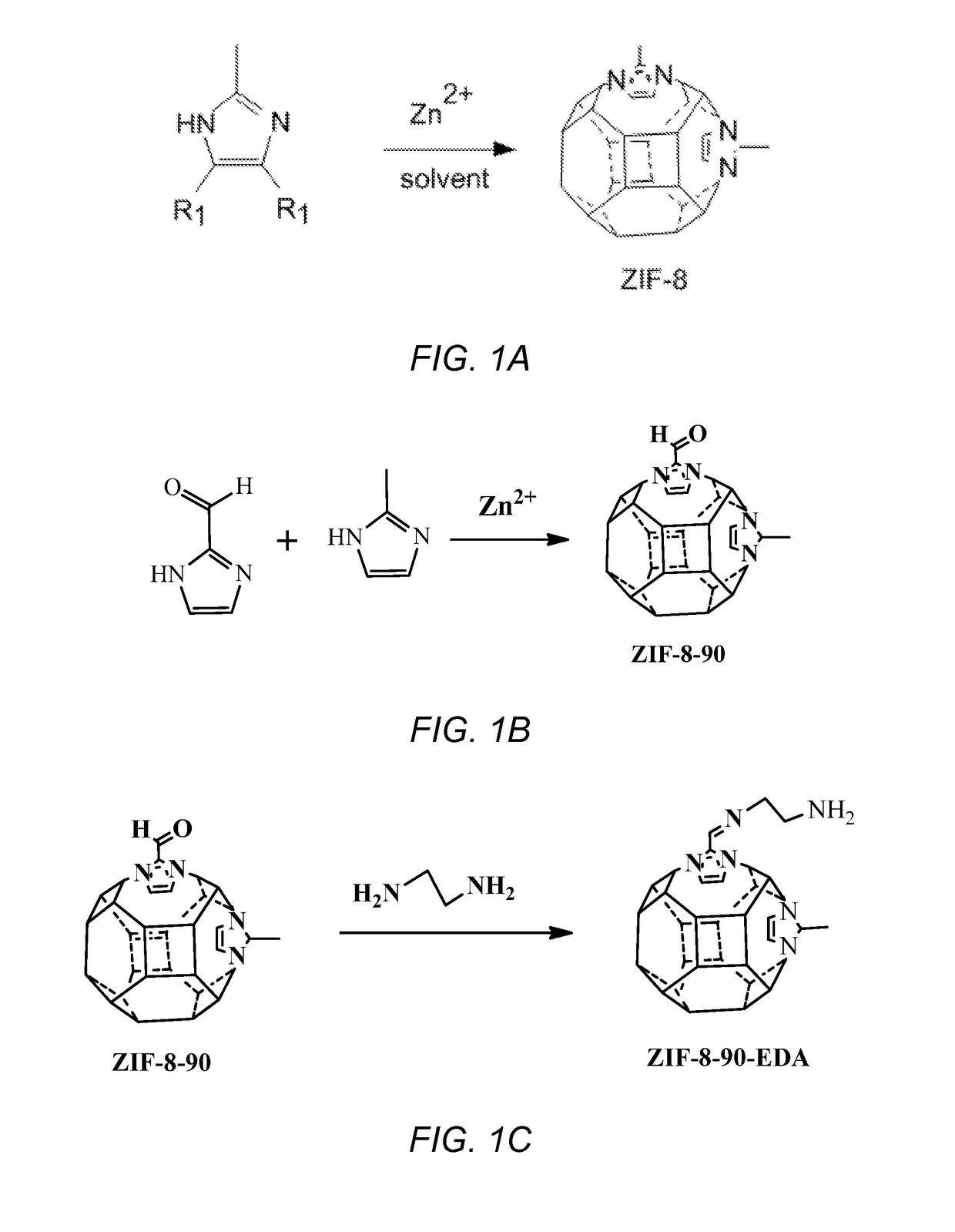Modification of zeolitic imidazolate frameworks and azide cross-linked mixed-matrix membranes made therefrom
- Summary
- Abstract
- Description
- Claims
- Application Information
AI Technical Summary
Benefits of technology
Problems solved by technology
Method used
Image
Examples
example 1
Synthesis of 1,1′-Oxybis(4-azidobenzene)
[0086]4,4′-oxydianiline (4 g, 20 mmol) was dissolved in water (20 mL) containing concentrated HCl (11 mL, 37%), cooled to 0° C., and then treated drop wise with a solution of sodium nitrite (3.45 g, 50 mmol) in water (12 mL). After the addition, the reaction was maintained at 0-5° C. for 1.5 h. To the resultant clear solution was added sodium azide (3.2 g, 5 mmol) in water (12 mL). The solution was stirred for 15 min. The resulted solid was collected and washed with water. A pale yellow solid was obtained by recrystallization from ethanol. Yield=80%. The resulting solid was characterized by 1H-NMR (CDCl3): δ 7.0 (s, 8H) and 13C-NMR (CDCl3): δ 154.3 (2C), δ 135.1 (2C), δ 120.1 (8C) and confirmed to be 1,1′-oxybis(4-azidobenzene).
example 2
Synthesis of ZIF-8 Particles
[0087]A solution of Zn(NO3)2.6H2O (5 g, 16.8 mmol) in 100 mL of methanol was rapidly poured into a solution of 2-methylimidazole (12 g, 146.2 mmol) in 100 mL of methanol under stirring. The mixture slowly turned turbid and after 3 h the particles were separated from the milky dispersion by centrifugation and washed 3 times with fresh methanol. The particles were dried at 100° C. under vacuum. The particle size was about 500 nm. FIG. 7 is a scanning electron microscope image of the ZIF-8 particles. The structure of the ZIF-8 structure was confirmed by XRD by comparison of XRD pattern to a simulated ZIF-8 XRD pattern. FIG. 8 are an XRD patterns of the simulated ZIF-8 (pattern 802), synthesized ZIF-8 (pattern 804), and the ZIF-8 functionalized with the diazide of Example 1 (pattern 806). The BET surface area of the particles was determined to be about 1765.1 m2 / g.
example 3
Synthesis of Polyimide 6FDA-DAM
[0088]To a 250 mL of three-neck round flask, 4,4′-(Hexafluoroisopropylidene)diphthalic anhydride (10 mmol) and 3,6-diaminodurene (10 mmol) was dissolved in anhydrous N-Methyl-2-pyrrolidone (NMP, 30 mL) and stirred for 24 h under N2 atmosphere. Acetic anhydride (226.6 mmol) and pyridine (11.55 mmol) were added to the reaction mixture, and the mixture was stirred for 48 h. The resulting polymer was precipitated by pouring the solution into methanol. The precipitation process was repeated 2 times. A white polymer was isolated and dried at 120° C. under vacuum for 48 h. 1H-NMR (400 MHz, CDCl3): δ 8.12 (s, 2H), 8.00 (s, 4H), 7.29 (s, 1H), 2.27 (s, 6H), 2.03 (s, 3H). Molecular weight: Mn=3.16×104 g·mol−1, PDI=2.15.
PUM
| Property | Measurement | Unit |
|---|---|---|
| Temperature | aaaaa | aaaaa |
| Temperature | aaaaa | aaaaa |
| Fraction | aaaaa | aaaaa |
Abstract
Description
Claims
Application Information
 Login to View More
Login to View More - R&D
- Intellectual Property
- Life Sciences
- Materials
- Tech Scout
- Unparalleled Data Quality
- Higher Quality Content
- 60% Fewer Hallucinations
Browse by: Latest US Patents, China's latest patents, Technical Efficacy Thesaurus, Application Domain, Technology Topic, Popular Technical Reports.
© 2025 PatSnap. All rights reserved.Legal|Privacy policy|Modern Slavery Act Transparency Statement|Sitemap|About US| Contact US: help@patsnap.com



